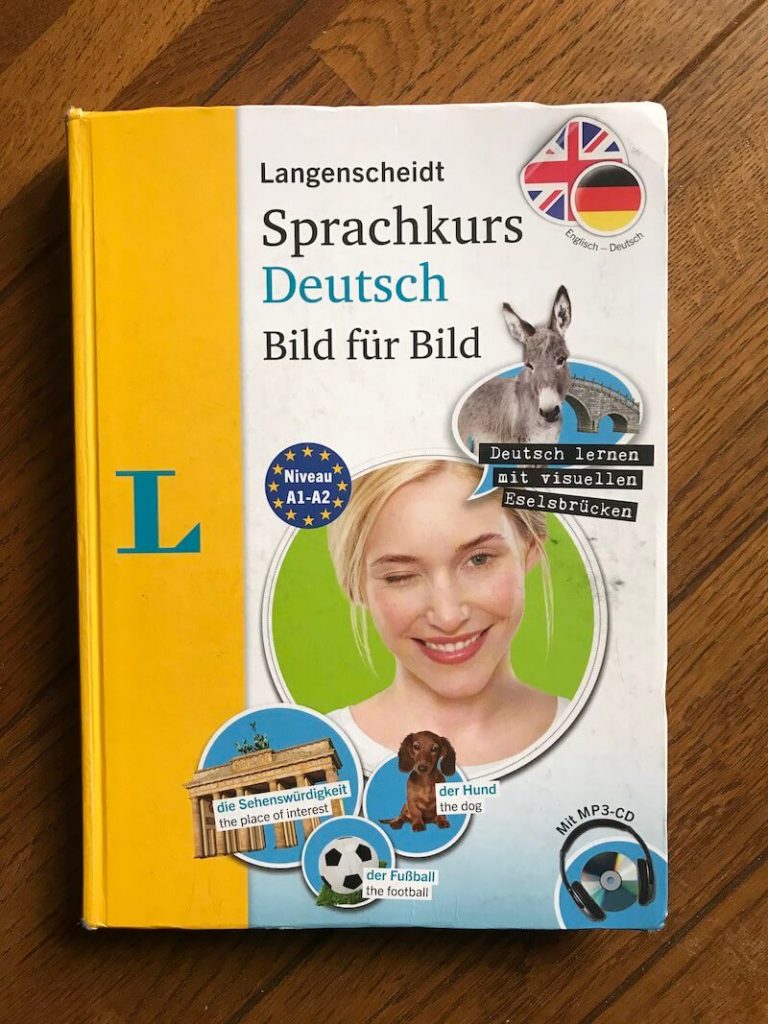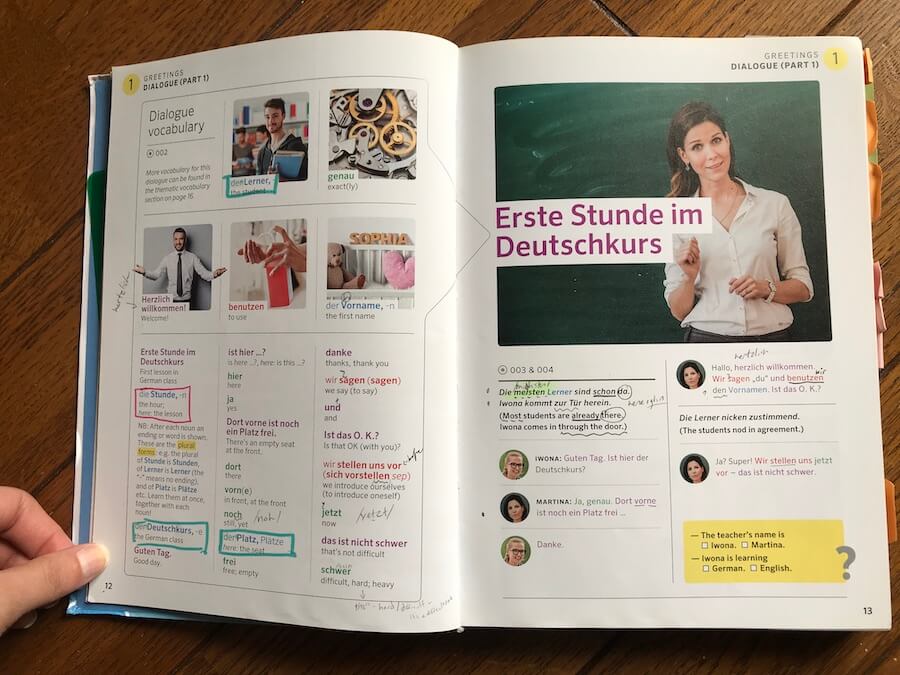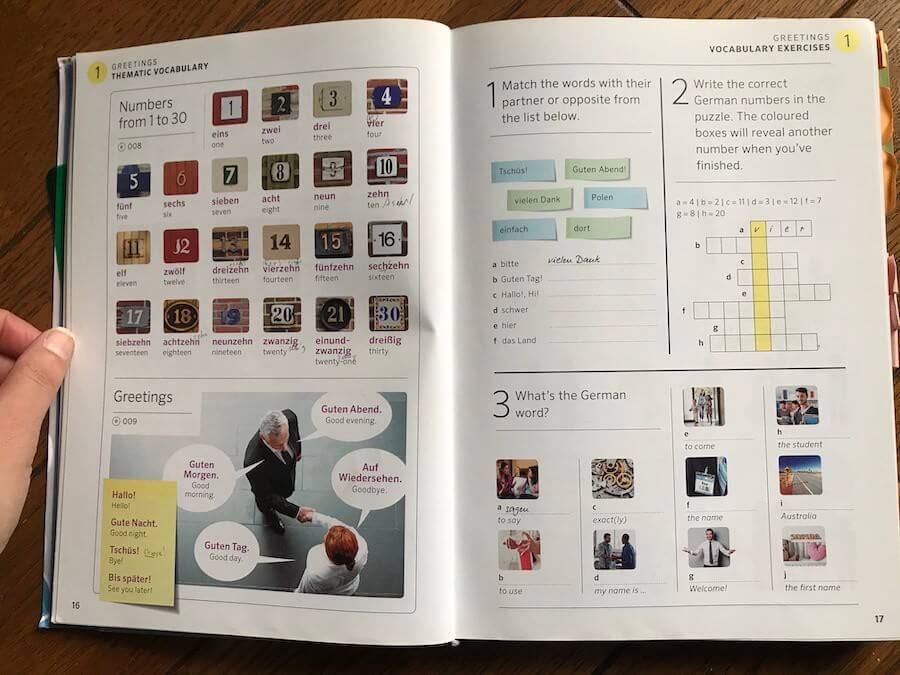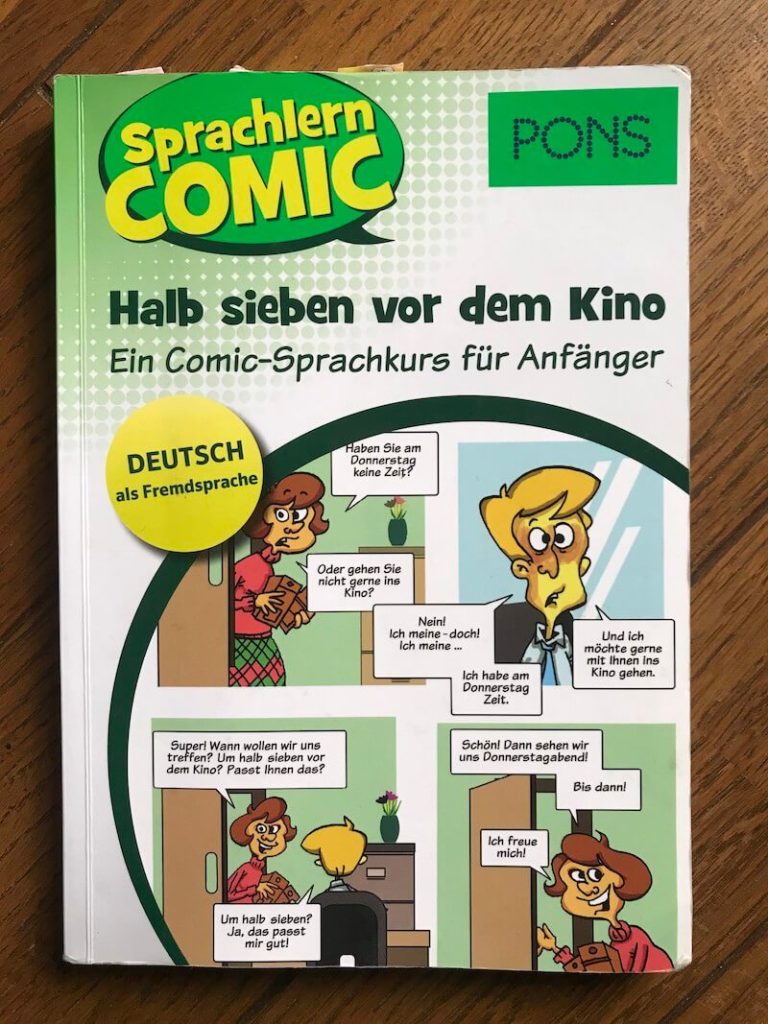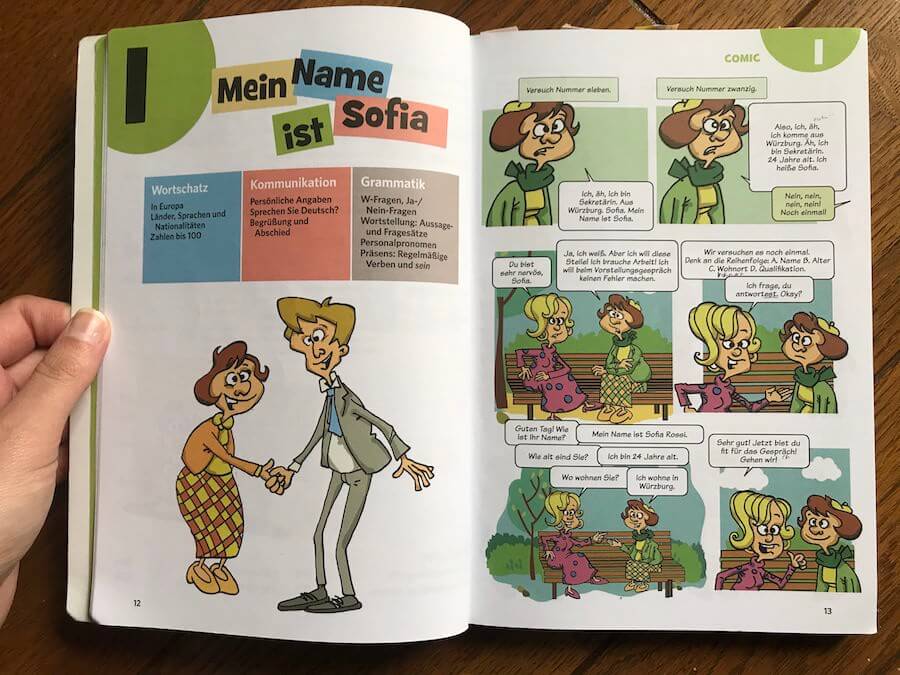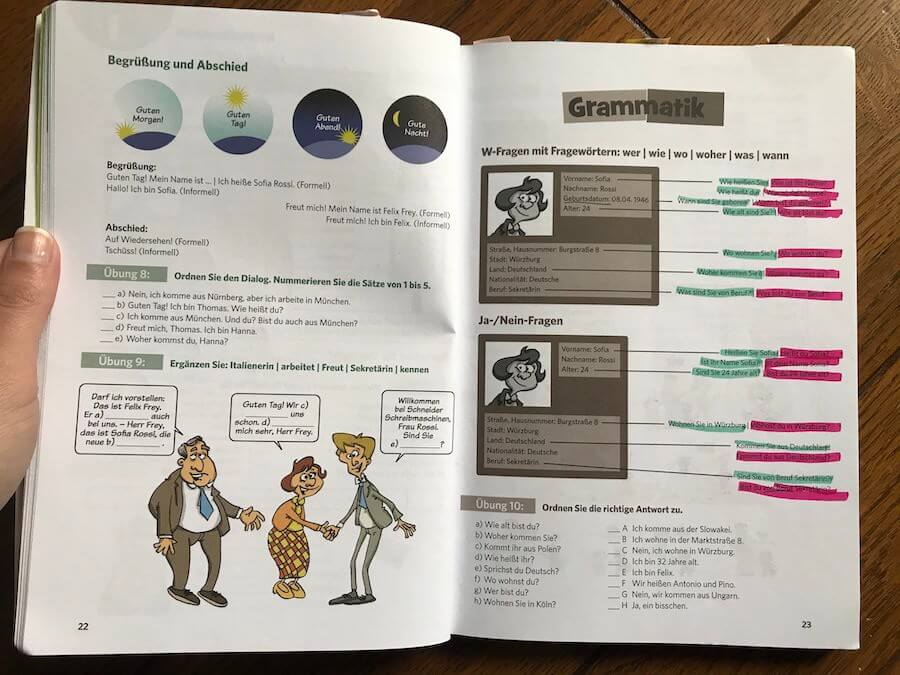If you’re anything like me, I never thought I’d be able to understand a lick of German. I tried all four years of college to work a single German class into my schedule and failed. I bought an old-school German textbook that I tried to work through on my own, but all I kept thinking was: these “articles” are der, die, DUMB, and the sentence structure made as much sense to me as people who like E.T..
Life truly seemed too short to learn German.
But it isn’t! A little over a year after I decided to put my lifespan on the line, I am the possessor of the A1 and A2 Goethe Institut language certificates and on track to get B1 this upcoming August. Boo-yah! Take that, Oscar Wilde!

And because I…
- Didn’t pay for a class at the Goethe Institut or other language school,
- Didn’t pay for any online courses,
- Started as an adult,
- And have a full-time job,
It means that if you do what I did, you…
- Won’t waste money on classes,
- Won’t have to travel all the way to a school,
- CAN learn a new language with your adult brain,
- Can study despite your busy work schedule, and…
- WILL GET YOURSELF THE A1 & A2 CERTIFICATES!!!
Seriously!
You can do it on a dime (you’ll pay only for your textbooks and German tutor, both of which are essential), and if you actually do the stuff I’ve detailed here, we can both be sticking our tongues out at Sir Wilde, the pansy who gave up on this dope language and rudely discouraged future generations of learners (boooo!).
What’s in this post:
The 6 Things You Gotta Do
1) Don’t focus on just one aspect of the language
2) Use it or lose it!
3) Work on your accent
4) Invest in a good textbook!
5) Get a tutor
6) Stay! In! Your! Lane!!
13 (Mostly) Free & Amazing Resources IN YOUR LANE!
YouTube videos! Podcasts! Books! Apps, even!
The 6 Things You Gotta Do
1) Don’t focus on just one aspect of the language
I cannot understand people who say that they “just want to learn how to speak.” They seem to think that being able to read and write means having to understand novels and philosophy. But it doesn’t. Most of us communicate nowadays with texting, email, and social media – all of which we need to know how to read and write to use.
Not to mention how much just focusing on one facet of language severely limits your access to the world of the other language. Just think about how much you speak, listen, read, and write in English on any given day. Now imagine doing only one of those things, all day. Then every day. Not a very interesting world now, is it?
Any seasoned learner will tell you that the more aspects of the language you stick your toes in, the more likely you are to get used to it, and thus learn, naturally. This is because children don’t learn language in just one way. They grow up listening to it, then seeing it on signs and papers and things around them, then speaking it with their parents, and progressing to writing their names and thoughts and so on at school. They have years of full-time exposure before they even say their first word. You too will learn faster and better when you engage with language on all fronts.

This is why standardized language tests like those from the Goethe Institut are comprehensive. To pass them, you’ll need to balance your language skills. Yes, you will likely be better at one thing than another, but your levels shouldn’t be worlds apart. If you do a practice test and find that any one skill is severely lacking, don’t let it slide. Try adding in some of the resources I suggest below.
2) Use it or lose it!
First, the good news: you don’t have to study every day.
BUT! And this is a very important BUT,
You have to study regularly.
And really, you should study or review every day. But if you can’t do that, you need to put it in a regular time slot in your schedule and stick to it.
This is especially true when you’re just starting out – the fundamentals are the hardest and most important. It takes time for your brain to get used to the look and sound of a foreign language, and time for those fundamentals to stick. There’s no skipping around it – but if you give your brain that time, you’ll get more comfortable with the language and it will just come out of your mouth naturally as if it were magic.

I stress – don’t waste your time and effort by lazily cutting out time for review and study sessions. I’ve done this too many times and always regretted it. If you take too much time in between, your foundation will disappear. Then you’ll have to start all over again to get it back. It’s not worth it!
What I like to do is set a 25-minute “Pomodoro Timer,” also known as a Tomato Timer. Although there’s some science behind it, for me, the 25-minute limit works because it’s just short of a half an hour, which sometimes sounds like too much time for any one thing. After the timer’s gone off, I often find myself thinking like, “Whoah! Already?” and continuing for another cycle or two. (Get the Mac app here.)
3) Work on your accent
Have you ever heard an accent so bad it hurt your ears? I did. When I was taking the speaking test for A2, I could barely understand my partner’s German accent. I had to keep asking him to repeat himself and even the test proctors looked confused. I’m pretty sure he didn’t pass.

Even if my speaking partner’s vocabulary was huge and his grammar perfect, he had such a bad accent that no one could understand him – and I would even go as far as to say that no one wanted to. You don’t want to be like that guy, do you?
As with all things, you won’t sound like a native with every word from the start, but there are a few things you can do to put you on the right track. Aside from what you can already guess you should do (like listening to and imitating native speakers), the real key to the German accent, or any accent for that matter, is the mouth.
How someone moves their mouth shows how they make the sounds of their language. You could just look at someone’s mouth and figure out what language they’re speaking.
Take a look at this video from Easy German (a fantastic YouTube channel). Watch Carina’s mouth. Notice how you can almost always see her front teeth, and how her teeth never touch her lips as they might in English. Germans speak from the front, as if they’re about to whistle.
It is the same mouth position that produces the German accent when Germans speak English. Watch Frau von Hammersmark’s mouth as she speaks English in an unmistakably German accent in this scene from ‘Inglorious Basterds’. It looks very similar to Carina’s when she speaks German.
To drive the point home, now compare both mouths to a normal English speaker’s mouth. You can see that the English mouth moves a lot more and in different ways than the German one.
The position of the German mouth is why their pronunciation is so clear. I personally love the clarity in which words sound when Germans speak English. One of my favorite German-English voices is from Coffee Break German’s “Cultural Correspondent” Julia.
All in all – if you want to sound German, your mouth should be moving like a German’s. Watch and imitate the mouths in the videos above, and then approach the words in your textbooks and so on in the same way. You will notice an instant improvement in your pronunciation, and German words will become much easier to say.
4) Invest in a good textbook!
The most important thing on your A1-A2 language journey and beyond is going to be the steady, guiding hand of a good old-fashioned textbook.
Yes, a physical textbook. One you can flip through the pages, one you can hold in your hands, mark with sticky-notes and highlighters; one with practice questions and dialogues, grammar explanations, the whole nine yards.

This is not to say that I don’t like apps – well, I don’t actually – but they should be seen as supplements to a good textbook. Or extra. Or additional practice. I suggest a few solid apps below, but the fact is that no one app can replace the comprehensiveness of a physical textbook (with well-made audio CDs!).
The primary reason why I like textbooks is because when you’re just getting started in a language, especially on your own, it’s overwhelming – What words should you learn first? What grammar? What should I know how to say at this level? A solid introductory textbook answers those questions and more, and provides you ample listening, reading, grammar, and even speaking practice.
Now, there are a lot of textbooks out there, some good and some bad, and some really really really bad. But luckily for you, I consider myself to be a bit of a ‘connoisseur’ of textbooks, and I have two that I used in particular to prepare me for the A1 and A2 exams.
Sprachkurs: Deutsch Bild für Bild (Langenscheidt)
I have always been a big fan of the iconic Langenscheidt brand with its yellow spine and blue font, and when I was in Berlin looking for an appropriate textbook to start my German studies with, I stumbled upon the biggest bookstore in the city and hit the jackpot – an entire grand section of Langenscheidt publications. I was in heaven.

After spending what felt like hours looking through every single introductory German textbook in the foreign language section, I settled on two books, the first being this baby.
What’s so great about it?
- English explanations, translations, and glossary
- Real-life pictures
- Modern print design
- Interesting story & characters
- Ample practice questions & answers
- Audio CD for vocabulary, dialogues, and practice questions
- Geared towards adults
- Suited for independent learners
- It’s Langenscheidt!
On a personal note, it also smells really good…

I suggest working your way through this one while watching Nico’s Weg A1 (below) and reading the Easy German Reader (also below).
Comic-Sprachkurs Deutsch: Halb sieben vor dem Kino (Pons)
The second of the two textbooks I purchased in Berlin (as I never rely on just one source, and neither should you) was this one. I chose it because it seemed suited for independent adult learners, and it had these peculiar comics that reminded me of the comic books my sister brought home from her trip to Germany when I was a kid.
It turned out to be a fantastic resource. It’s written entirely in German, but because I was using the Langenscheidt book with English translation simultaneously and their contents often overlapped, it wasn’t hard to understand. When I didn’t know a word, I just looked it up. That also served to be good practice to familiarizing myself with German – the entire book is example sentences.
Although it didn’t come with a CD for the comic dialogues, I got the two children of a German family I knew to kindly record them for me. I also already had a CD from the Langenscheidt book and audio from the YouTube channels I was watching, so it wasn’t a big deal. (Another reason why using multiple sources for your study is a pro move!)
You’ll like this book because the comics are funny, the exercise questions, vocabulary, and storylines are for adults, and each lesson has a lot of useful content in a fun format. There are tons of varied practice questions to keep you busy and your grammar in tip-top shape.
5) Get a tutor!

For reasons I go into in-depth here in this article, it is absolutely essential that you get yourself a tutor. There is no better way to get speaking, speaking correctly, and speaking regularly.
You should find a teacher, not a friend, and pay them on a regular basis. This way you are always guaranteed an hour of German speaking a week and can get what you say and write corrected by a fluent speaker.
I also suggest finding a bilingual tutor so that you’re not crippled with fear asking a question when you get stuck (yes, I’ve been there).
I found mine on Preply, an online language tutor service. Use this link to get a 30% discount off your first lesson (which gives me a discount too!).
6) Stay! In! Your! Lane!!
One of the biggest reasons why I insist you get a physical textbook to use as your primary language resource is because you can pace yourself and gradually build up your skills and vocabulary. Otherwise, you get lost trying to figure out what you should be learning at your level and just try to do too much.
You have to accept that you’re not as good as you want to be yet, but know that you will be if you take it easy and work your way up. This is difficult for a lot of people to do, because it’s natural to want to know everything from the get-go.
I myself have been guilty of this. I wanted to know everything from the start, I wanted to be able to explain every aspect of my life, my background, my job, and relationships. I wanted to be instantly fluent, and I soon found myself drowning in vocabulary lists and grammar charts way beyond what I would expect any beginner who was learning English for the first time to know.

Look here at what the A1 & A2 tests cover (Source):
A1
- understand and use familiar everyday expressions and very basic phrases aimed at the satisfaction of needs of a concrete type.
- introduce yourself and others and can ask and answer questions about personal details such as where he/she lives, people he/she knows and things he/she has.
- interact in a simple way provided the other person talks slowly and clearly and is prepared to help.
A2
- Can understand sentences and frequently used expressions related to areas of most immediate relevance (e.g. very basic personal and family information, shopping, local geography, employment).
- Can communicate in simple and routine tasks requiring a simple and direct exchange of information on familiar and routine matters.
- Can describe in simple terms aspects of their background, immediate environment and matters in areas of immediate need.
As you can see, there’s no reason to overdo it! Don’t go out and buy Freud in the original German and beat yourself up when you can’t understand it. You’re not supposed to. You’re just starting out! Give yourself some time to get your feet wet in German and get comfortable with the look, sound, and syntax of this tricky little language.
Imagine that you were talking to a first-time independent English learner. What would you expect them to be able to say after only a few lessons? In six months? In a year? Then consider that they’re also studying all by themselves. If you ever get overwhelmed, try to imagine yourself as that English newbie.

Slow and steady wins the race. What you should do it stick to content that is made for A1 & A2. Use graded readers. Focus on mastering the content in your textbook(s). That’s how you’ll build the foundation for zooming up to higher levels later and get yourself the A1 and A2 certificates on the way!
Whew! Now that we’re all primed and ready for success, are you ready to get those certificates?

Without further ado, here are the resources I used to pass the A1 and A2 exams.
I recommend you integrate all of them in your study plan in some way (see #1 for why), and, viel Glück! (Good luck!)
13 (mostly) FREE & Effective German Resources
that are IN YOUR LANE
Online Translation App:
1) DeepL Translator
Online Dictionary:
2) Dict.cc
YouTube Films:
3) Nico’s Weg A1
4) Nico’s Weg A2
‘Nico’s Weg’ are absolutely fantastic, well-written, adults-focused, fun, well-made, and IN YOUR LANE full-length instructional films (!!!!) by Deutsche Welle. I have watched them multiple times and can’t get enough. They also have German subtitles!! Top-tier recommend.
YouTube Channel:
5) Easy German
Real Germans answering everyday questions from an interesting host who speaks with clear and slow German pronunciation. These also have subtitles in German and English! Not every topic is easy for beginners but the ones that are aren’t hard to find and are a-plenty. I recommend this one for starters.
Podcast:
6) Coffee Break German (Season 2)
Subscribe and get magnificent extra goodies like full transcripts of the example sentences, vocab, and grammar used in the podcasts plus extra practice. I didn’t subscribe but was very tempted to. I’m sure it’s worth it just judging from the quality of the free version.
Books (not free but between $3-7 to have forever):
7) German Easy Reader (Super 500 for Beginners) by Brian Smith
This guy writes tons of books like these and they’re spectacular ways to learn. Check out the Pre-Intermediate book he offers here.
8) A Little Bit in English oder ein bisschen Deutsch by Kristi Winters
Apps:
9) Goethe A1 (amazing free vocabulary trainer)
10) Goethe A2 (costs $2 but basically free at that price!)
11) Goethe Institut LernDeutsch (interactive game)
12) DW Learn German by Deutsche Welle
News & Culture
13) Nachrichten.de
Let me know if any of these helped you out, which ones you liked the most, or if you have any suggestions that may help a newbie! 🙂

